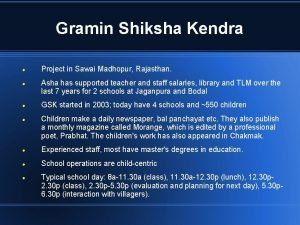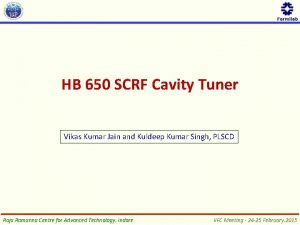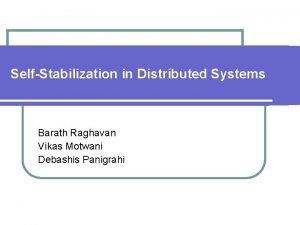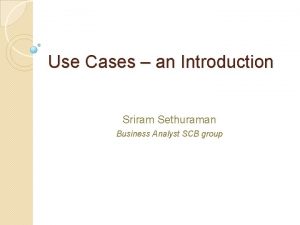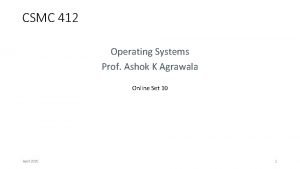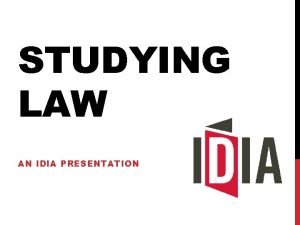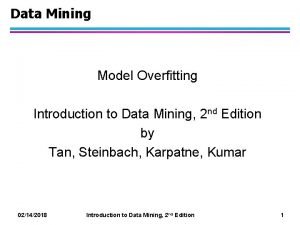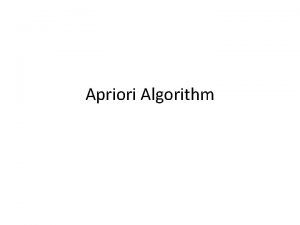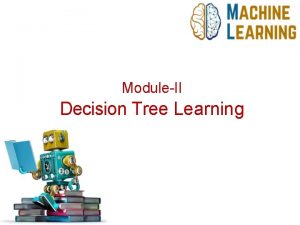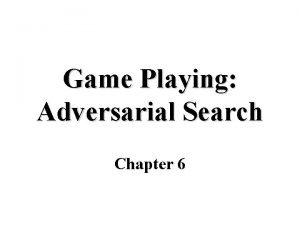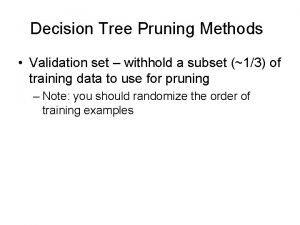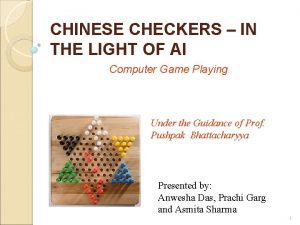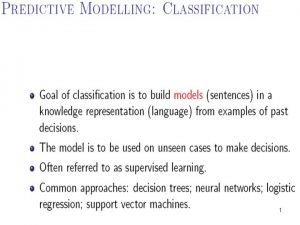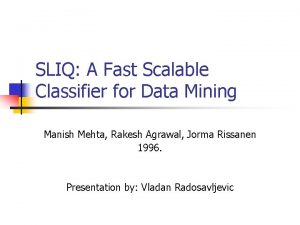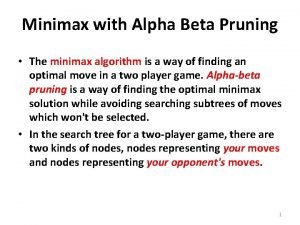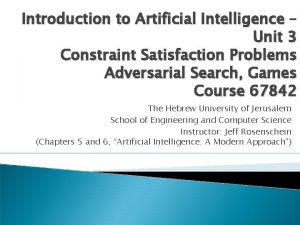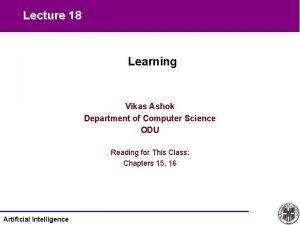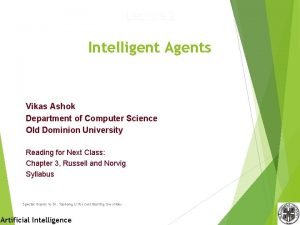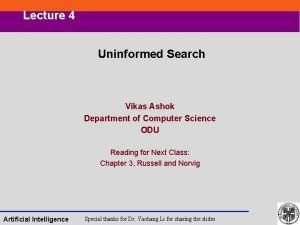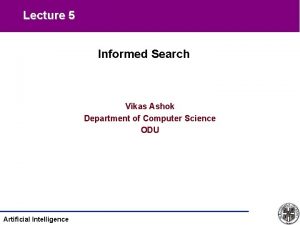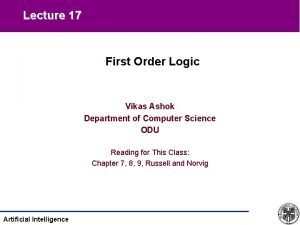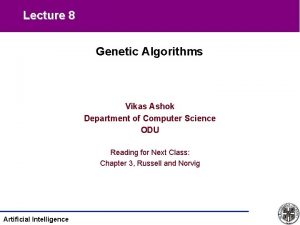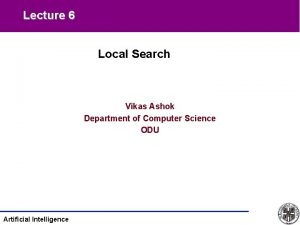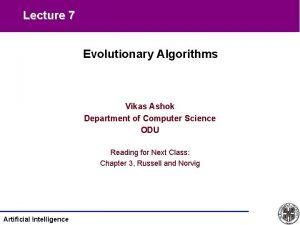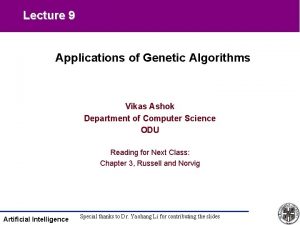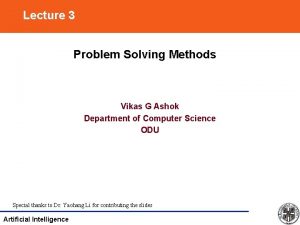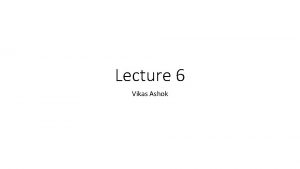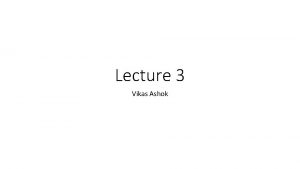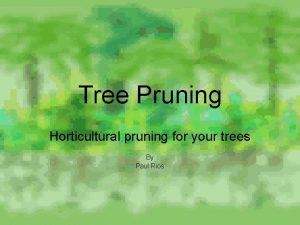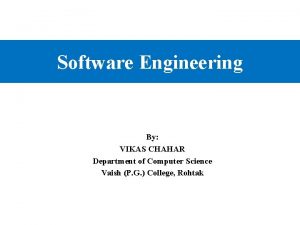Lecture 13 Pruning Vikas Ashok Department of Computer















































- Slides: 47

Lecture 13 Pruning Vikas Ashok Department of Computer Science ODU Reading for This Class: Chapter 7, Russell and Norvig Artificial Intelligence

Review • Last Class – Games – Adversarial Search • This Class – Pruning a Game Tree • Next Class – Knowledge-based Agent Artificial Intelligence

Imperfect Decisions • complete search is impractical for most games – Even though we can prune the tree • alternative: – search only part of the tree • Cutoff required • requires a cutoff-test to determine where to stop – use a heuristics-based evaluation function to estimate the expected utility of the game from a given position Artificial Intelligence

Evaluation Function • • determines the performance of a game-playing program must be consistent with the utility function – values for terminal nodes must be the same • tradeoff between accuracy and time cost – without time limits, minimax could be used • • should reflect the actual chances of winning frequently weighted linear functions are used – E = w 1 f 1 + w 2 f 2 + … + w n fn – combination of features, weighted by their relevance Artificial Intelligence

Example: Tic-Tac-Toe • simple evaluation function E(s) = (rx + cx + dx) - (ro + co + do) where r, c, d are the numbers of row, column and diagonal lines still available; x and o are the pieces of the two players • 1 -ply lookahead – start at the top of the tree – evaluate all 9 choices for player 1 – pick the maximum E-value • 2 -ply lookahead – also looks at the opponents possible move • assuming that the opponents picks the minimum E-value Artificial Intelligence

Tic-Tac-Toe 1 -Ply E(s 0) = Max{E(s 11), E(s 1 n)} = Max{2, 3, 4} = 4 E(s 11) 8 X -5 =3 E(s 12) X 8 -6 =2 Artificial Intelligence E(s 13) X 8 -5 =3 E(s 14) 8 -6 X =2 E(s 15) 8 X -4 =4 E(s 16) 8 X- 6 =2 E(s 17) 8 -5 X =3 E(s 18) 8 -6 X =2 E(s 19) 8 -5 X= 3

Tic-Tac-Toe 2 -Ply E(s 0) = Max{E(s 11), E(s 1 n)} = Max{2, 3, 4} = 4 E(s 1: 1) 8 X -5 =3 E(s 1: 2) X 8 -6 =2 E(s 1: 3) X 8 -5 =3 E(s 1: 4) 8 -6 X =2 E(s 1: 5) 8 X -4 =4 E(s 1: 6) 8 X- 6 =2 E(s 1: 7) 8 -5 X =3 E(s 1: 8) 8 -6 X =2 E(s 2: 41) 5 O X -4 =1 E(s 2: 42) O 6 X -4 =2 E(s 2: 43) O 5 X -4 =1 E(s 2: 44) 6 OX - 4 =2 E(s 2: 45) 6 X O- 4 =2 E(s 2: 46) 5 X -4 O =1 E(s 2: 47) 6 X -4 O =2 E(s 2: 48) 5 X -4 O= 1 E(s 2: 9) 5 OX -6 = -1 E(s 2: 10) XO 5 -6 = -1 E(s 2: 11) X 5 -6 O = -1 E(s 2: 12) 5 X O -6 = -1 E(s 2: 13) 5 X O-6 = -1 E(s 2: 14) 5 X -6 O = -1 E(s 2: 15) 5 X -6 O = -1 E(s 2: 16) 5 X -6 O = -1 E(s 22) X O 5 -5 =0 E(s 23) 6 X -5 O =1 E(s 24) E(s 25) 4 X 6 X O -5 O- 5 = -1 =1 E(s 26) 5 X -5 O =0 E(s 27) 6 X -5 O =1 E(s 28) 5 X -5 O= 0 E(s 21) XO 6 -5 =1 Artificial Intelligence E(s 1: 9) 8 -5 X= 3

Checkers Case Study • initial board configuration – Black – Red single on 20 single on 21 king on 31 single on 23 king on 22 – evaluation function E(s) = (5 x 1 + x 2) - (5 r 1 + r 2) where x 1 = black king advantage, x 2 = black single advantage, r 1 = red king advantage, r 2 = red single advantage 1 5 6 9 13 7 14 21 3 10 17 12 16 19 23 26 30 8 15 22 4 11 18 25 29 Artificial Intelligence 2 20 24 27 31 28 32

Checkers Minimax Example 3 6 10 15 18 22 25 20 23 27 1 28 0 22 -> 26 25 -> 0 0 -4 -4 -8 -8 17 0 21 -> 2 20 -> 16 1 > 17 1 21 - 16 -> 11 -8 20 -> 16 1 > 17 31 -> 27 22 -8 21 - > 27 16 -> 11 32 30 31 - -> -> 31 1 -4 27 -> 31 > 26 31 - 6 4 1 -> 2 1 MIN MAX 31 Artificial Intelligence 1 0 27 1 1 2 -> 1 1 31 1 7 1 13 6 -8 27 1 >1 6 1 1 -> 14 1 1 18 -> 2 6 221 -> 31 21 -> 17 6 -> 2 23 23 -> 262 -8 23 32 MAX 23 31 27 22 -> 30 24 -> 22 -> 29 16 19 26 20 -> 26 21 12 31 7 17 11 16 -> 14 8 31 13 7 21 -> 1 9 1 4 20 -> 16 5 2 20 -> 16 1 -8 -8

Difficulty in Evaluation Function • • Very difficult to develop an appropriate evaluation function Example – Two slightly different chess positions • A. black has an advantage of a knight and two pawns and will win the game • B. back will lose after white captures the queen Artificial Intelligence

Horizon Problem • moves may have disastrous consequences in the future, but the consequences are not visible – the corresponding change in the evaluation function will only become evident at deeper levels • they are “beyond the horizon” • determining the horizon is an open problem without a general solution – only some pragmatic approaches restricted to specific games or situation Artificial Intelligence

Pruning • discards parts of the search tree – guaranteed not to contain good moves – high likelihood that the solution is not in the branch or subtree • results in substantial time and space savings – the leftover part of the task may still be exponential, however Artificial Intelligence

Mathematics under Pruning MINIMAX-VALUE(root) =max(min(3, 12, 8), min(2, x, y), min(14, 5, 2)) =max(3, min(2, x, y), 2) In such a case, regardless what value x and y will be, it wouldn’t affect the minimax value. Artificial Intelligence

Alpha-Beta Pruning • moves that with certainty won’t result in a better evaluation value than a move further up in the tree are not considered – they would lead to a less desirable outcome • applies to moves by both players – a indicates the best choice for Max so far never decreases – b indicates the best choice for Min so far never increases • extension of the minimax approach – results in the same move as minimax, but with less overhead – prunes uninteresting parts of the search tree Artificial Intelligence

Alpha-Beta Algorithm Artificial Intelligence

Alpha-Beta Pruning Example Artificial Intelligence

Alpha-Beta Pruning Example Artificial Intelligence

Alpha-Beta Pruning Example Artificial Intelligence

Alpha-Beta Pruning Example Artificial Intelligence

Alpha-Beta Pruning Example Artificial Intelligence

Alpha-Beta Pruning Example Artificial Intelligence

Alpha-Beta Pruning Example Artificial Intelligence

Alpha-Beta Pruning Example Artificial Intelligence

Alpha-Beta Pruning Example Artificial Intelligence

Alpha-Beta Pruning Example Artificial Intelligence

Alpha-Beta Pruning Example Artificial Intelligence

Exercise Artificial Intelligence

Exercise Artificial Intelligence

The general case of Alpha-Beta Pruning If m is better than n for Player, we will never get to n to play This is Alpha-cutting Artificial Intelligence

Checkers Alpha-Beta Example 1 1 16 31 28 32 0 20 -> 16 -4 -4 -8 -8 17 0 21 -> 16 -> 11 27 20 -> 16 0 > 17 2 21 - 31 -> 27 24 -8 20 -> 16 1 > 17 1 -8 21 - 20 -> 16 22 -> 26 25 26 20 32 -> 19 -> 22 12 16 23 30 30 > 27 16 -> 11 15 22 29 -> 31 1 -4 27 -> 31 > 26 31 - 11 23 23 22 -> 18 1 22 -> 6 4 1 -> 2 1 31 Artificial Intelligence 1 0 27 1 1 2 -> 1 1 31 1 7 1 1 6 -8 8 18 25 -4 7 14 17 4 27 1 >1 6 -> 14 1 1 1 -> 2 6 18 31 21 -> 221 -> 6 -> 2 23 23 MAX 17 13 26 3 10 21 0 MIN -> 262 -> 26 7 1 6 9 -> 20 -> 31 31 MAX - 6 5 21 -> 1 a b 2 -8 -8

Checkers Alpha-Beta Example 1 1 7 1 31 28 32 0 20 -> 16 -4 -4 -8 -8 17 0 21 -> 16 -> 11 27 20 -> 16 0 > 17 2 21 - 31 -> 27 24 -8 20 -> 16 1 > 17 1 -8 21 - 20 -> 16 22 -> 26 25 26 20 32 -> 19 -> 22 12 16 23 30 30 > 27 16 -> 11 15 22 29 -> 31 1 -4 27 -> 31 > 26 31 - 11 23 23 22 -> 18 1 22 -> 6 4 1 -> 2 1 31 Artificial Intelligence 1 0 27 1 1 2 -> 1 1 31 1 7 1 1 6 -8 8 18 25 -4 7 14 17 4 27 1 >1 6 -> 14 1 1 1 -> 2 6 18 31 21 -> 221 -> 6 -> 2 23 23 MAX 17 13 26 3 10 21 0 MIN -> 262 -> 26 1 16 6 9 -> 20 -> 31 31 MAX - 5 21 -> 1 a b 2 -8 -8

Checkers Alpha-Beta Example 1 - 16 24 27 31 28 32 0 -4 -4 -8 -8 17 0 21 -> 0 20 -> 16 2 > 17 1 21 - 16 -> 11 20 -8 20 -> 16 1 > 17 31 -> 22 26 -8 21 - 20 -> 16 22 -> 26 25 -> 22 19 32 30 > 27 16 -> 11 16 23 30 12 -> -> 31 1 -4 27 -> 31 > 26 31 - 15 22 29 11 23 23 22 -> 18 1 22 -> 6 4 1 -> 2 1 31 Artificial Intelligence 1 0 27 1 1 2 -> 1 1 31 1 7 1 1 6 -8 8 18 25 -4 7 14 17 4 27 1 >1 6 -> 14 1 1 1 -> 2 6 18 31 21 -> 221 -> 6 -> 2 23 23 MAX 17 13 26 3 10 21 0 MIN -> 262 -> 26 1 6 9 -> 7 b- cutoff: no need to examine further branches 20 -> 31 31 MAX 21 -> 1 1 2 5 20 -> 16 a b 1 -8 -8

Checkers Alpha-Beta Example 1 - 16 24 27 31 28 32 0 -4 -4 -8 -8 17 0 21 -> 0 20 -> 16 2 > 17 1 21 - 16 -> 11 20 -8 20 -> 16 1 > 17 31 -> 22 26 -8 21 - 20 -> 16 22 -> 26 25 -> 22 19 32 30 > 27 16 -> 11 16 23 30 12 -> -> 31 1 -4 27 -> 31 > 26 31 - 15 22 29 11 23 23 22 -> 18 1 22 -> 6 4 1 -> 2 1 31 Artificial Intelligence 1 0 27 1 1 2 -> 1 1 31 1 7 1 1 6 -8 8 18 25 -4 7 14 17 4 27 1 >1 6 -> 14 1 1 1 -> 2 6 18 31 21 -> 221 -> 6 -> 2 23 23 MAX 17 13 27 3 10 21 0 MIN -> 262 -> 26 7 1 6 9 -> 20 -> 31 31 MAX 21 -> 1 1 2 5 20 -> 16 a b 1 -8 -8

Checkers Alpha-Beta Example 1 - 16 24 27 31 28 32 0 -4 -4 -8 -8 17 0 21 -> 0 20 -> 16 2 > 17 1 21 - 16 -> 11 20 -8 20 -> 16 1 > 17 31 -> 22 26 -8 21 - 20 -> 16 22 -> 26 25 -> 22 19 32 30 > 27 16 -> 11 16 23 30 12 -> -> 31 1 -4 27 -> 31 > 26 31 - 15 22 29 11 23 23 22 -> 18 1 22 -> 6 4 1 -> 2 1 31 Artificial Intelligence 1 0 27 1 1 2 -> 1 1 31 1 7 1 1 6 -8 8 18 25 -4 7 14 17 4 27 1 >1 6 -> 14 1 1 1 -> 2 6 18 31 21 -> 221 -> 6 -> 2 23 23 MAX 17 13 27 3 10 21 0 MIN -> 262 -> 26 1 6 9 -> 7 b- cutoff: no need to examine further branches 20 -> 31 31 MAX 21 -> 1 1 2 5 20 -> 16 a b 1 -8 -8

Checkers Alpha-Beta Example 1 16 24 27 31 28 32 0 -4 -4 -8 -8 17 0 21 -> 0 20 -> 16 2 > 17 1 21 - 16 -> 11 20 -8 20 -> 16 1 > 17 31 -> 22 26 -8 21 - 20 -> 16 22 -> 26 25 -> 22 19 32 30 > 27 16 -> 11 16 23 30 12 -> -> 31 1 -4 27 -> 31 > 26 31 - 15 22 29 11 23 23 22 -> 18 1 22 -> 6 4 1 -> 2 1 31 Artificial Intelligence 1 0 27 1 1 2 -> 1 1 31 1 7 1 1 6 -8 8 18 25 -4 7 14 17 4 27 1 >1 6 -> 14 1 1 1 -> 2 6 18 31 21 -> 221 -> 6 -> 2 23 23 MAX 17 13 27 3 10 21 0 MIN -> 262 -> 26 7 1 6 9 -> 20 -> 31 31 MAX 2 5 20 -> 16 1 1 21 -> 1 a b 1 -8 -8

Checkers Alpha-Beta Example 1 16 24 27 31 28 32 0 -4 -4 -8 -8 17 0 21 -> 0 20 -> 16 2 > 17 1 21 - 16 -> 11 20 -8 20 -> 16 1 > 17 31 -> 22 26 -8 21 - 20 -> 16 22 -> 26 25 -> 22 19 32 30 > 27 16 -> 11 16 23 30 12 -> -> 31 1 -4 27 -> 31 > 26 31 - 15 22 29 11 23 23 22 -> 13 1 22 -> 6 4 1 -> 2 1 31 Artificial Intelligence 1 0 27 1 1 2 -> 1 1 31 1 7 1 1 6 -8 8 18 25 -4 7 14 17 4 27 1 >1 6 -> 14 1 1 1 -> 2 6 18 31 21 -> 221 -> 6 -> 2 23 23 MAX 17 13 27 3 10 21 0 MIN -> 262 -> 26 7 1 6 9 -> 20 -> 31 31 MAX 2 5 20 -> 16 1 0 21 -> 1 a b 1 -8 -8

Checkers Alpha-Beta Example 1 16 24 27 31 28 32 0 -4 -4 -8 -8 17 0 21 -> 0 20 -> 16 2 > 17 1 21 - 16 -> 11 20 -8 20 -> 16 1 > 17 31 -> 22 26 -8 21 - 20 -> 16 22 -> 26 25 -> 22 19 32 30 > 27 16 -> 11 16 23 30 12 -> -> 31 1 -4 27 -> 31 > 26 31 - 15 22 29 11 23 23 22 -> 18 1 22 -> 6 4 1 -> 2 1 31 Artificial Intelligence 1 0 27 1 1 2 -> 1 1 31 1 7 1 1 6 -8 8 18 25 -4 7 14 17 4 27 1 >1 6 -> 14 1 1 1 -> 2 6 18 31 21 -> 221 -> 6 -> 2 23 23 MAX 17 13 27 3 10 21 0 MIN -> 262 -> 26 1 6 9 -> 7 a- cutoff: no need to examine further branches 20 -> 31 31 MAX 2 5 20 -> 16 1 -4 21 -> 1 a b 1 -8 -8

Checkers Alpha-Beta Example 1 16 24 27 31 28 32 0 -4 -4 -8 -8 17 0 21 -> 0 20 -> 16 2 > 17 1 21 - 16 -> 11 20 -8 20 -> 16 1 > 17 31 -> 22 26 -8 21 - 20 -> 16 22 -> 26 25 -> 22 19 32 30 > 27 16 -> 11 16 23 30 12 -> -> 31 1 -4 27 -> 31 > 26 31 - 15 22 29 11 23 23 22 -> 18 1 22 -> 6 4 1 -> 2 1 31 Artificial Intelligence 1 0 27 1 1 2 -> 1 1 31 1 7 1 1 6 -8 8 18 25 -4 7 14 17 4 27 1 >1 6 -> 14 1 1 1 -> 2 6 18 31 21 -> 221 -> 6 -> 2 23 23 MAX 17 13 27 3 10 21 0 MIN -> 262 -> 26 7 1 6 9 -> 20 -> 31 31 MAX 2 5 20 -> 16 1 -8 21 -> 1 a b 1 -8 -8

Properties of Alpha-Beta Pruning • in the ideal case, the best successor node is examined first – results in O(bd/2) nodes to be searched instead of O(bd) – alpha-beta can look ahead twice as far as minimax – in practice, simple ordering functions are quite useful • assumes an idealized tree model – uniform branching factor, path length – random distribution of leaf evaluation values • requires additional information for good players – game-specific background knowledge – empirical data Artificial Intelligence

Games and Computers • state of the art for some game programs – – – Chess Checkers Othello Backgammon Go Artificial Intelligence

Chess • Deep Blue, a special-purpose parallel computer, defeated the world champion, Gary Kasparov – the human player didn’t show his best game – Deep Blue used a massive data base with games from the literature Artificial Intelligence

Checkers • Chinook becomes world champion in 1994 – human opponent, Dr. Marion Tinsley, withdraws for health reasons • Chinook uses off-the-shelf hardware, alpha-beta search, end-games data base for six-piece positions Artificial Intelligence

Othello • many programs play far better than humans – smaller search space than chess – little evaluation expertise available Artificial Intelligence

Backgammon • neural-network based program ranks among the best players in the world – improves its own evaluation function through learning techniques – search-based methods are practically hopeless • chance elements, branching factor Artificial Intelligence

Go • humans play far better – large branching factor (around 360) • search-based methods are hopeless • • rule-based systems play at amateur level $2, 000 prize for the first program to defeat a top-level player – http: //www. gameai. com/clagames. html Artificial Intelligence

Summary • • • Game Tree Alpha-Beta Pruning Different Games Artificial Intelligence

What I want you to do • • Review Chapter 7 Work on your assignment Artificial Intelligence
 Dr vikas patel
Dr vikas patel Dr vikas patel
Dr vikas patel Dr vikas patel
Dr vikas patel Vagad vikas
Vagad vikas Enokj
Enokj Dhara vikas sikkim poster
Dhara vikas sikkim poster Pmagy nic.in
Pmagy nic.in Surajya sarvangin vikas prakalp
Surajya sarvangin vikas prakalp Gramin sarva shiksha vikas kendra
Gramin sarva shiksha vikas kendra Vikas kumar
Vikas kumar Vikas kumar
Vikas kumar Dr vikas bansal
Dr vikas bansal Dr vikas bhatia
Dr vikas bhatia Vikas motwani
Vikas motwani Gramin sarva shiksha vikas kendra
Gramin sarva shiksha vikas kendra Vikas lab thakur complex
Vikas lab thakur complex 01:640:244 lecture notes - lecture 15: plat, idah, farad
01:640:244 lecture notes - lecture 15: plat, idah, farad Ashok kumar pandey iith
Ashok kumar pandey iith Ashok sriram md
Ashok sriram md J v k rao committee
J v k rao committee Dr ashok goel
Dr ashok goel Ashok kolaskar
Ashok kolaskar Ashok mankad
Ashok mankad Ashok chandrasekhar
Ashok chandrasekhar Ca ashok batra
Ca ashok batra Ashok emani
Ashok emani Ashok agrawala
Ashok agrawala Ashok leyland low floor bus
Ashok leyland low floor bus Telecom billing concepts
Telecom billing concepts Donnie ashok
Donnie ashok Ashok stupa lalitpur
Ashok stupa lalitpur Neural networks ib psychology
Neural networks ib psychology Cane pruning
Cane pruning Cost complexity pruning
Cost complexity pruning Objective of pruning
Objective of pruning Cart pruning
Cart pruning Overfitting in data mining
Overfitting in data mining Apriori test
Apriori test Inductive bias in decision tree learning
Inductive bias in decision tree learning John 15 2
John 15 2 Alpha beta pruning
Alpha beta pruning Pessimistic error pruning
Pessimistic error pruning History of chinese checkers
History of chinese checkers Alpha beta pruning visualization
Alpha beta pruning visualization Reduced error pruning example
Reduced error pruning example Hybrid sliq pruning
Hybrid sliq pruning Minimax alpha beta pruning
Minimax alpha beta pruning Alpha beta pruning example
Alpha beta pruning example








